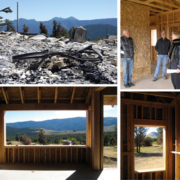Loss and Opportunity: Four Homes Rise from the Ashes Part II
by David Barrett, AIA
The idea that design can be a part of the healing process has been termed “restorative” or “regenerative” design. The cycle of life, death, and rebirth is one that nature models for us in homeostasis, and cultures celebrate in seasonal rituals that remind us of the spiritual message found in impermanence and even of death itself. When the Four Mile Fire raged through the foothills west of Boulder last Labor Day, 6,000 acres of mountain landscape were suddenly and drastically transformed. In its wake, 169 homes were destroyed and those who had lived in them were left with the challenge of reconstructing their lives, their dreams, their homes, and the precious landscapes they had inhabited.
Over this past year, as Architects, we have been invited into four projects that are engaged in this process. With each, we have the opportunity to touch the essence of restorative design in both human and ecological terms. This is Part Two of a four-part series, wherein we’ll be sharing the story of each of these homes, families, and individuals: their experience, the co-creative process, and the unfolding of the built form as a tool for creating positive energy, opportunity, and with it, a quality of healing.

We live in a culture geared to immediate gratification and short-term thinking. Sudden change, and even loss, can bring about opportunity for us to challenge our value systems, our sense of beauty, and our trust in the perfect unfolding of life itself.
These clients live in Wisconsin, and are deeply connected to their community, their work, and their roots. They also have a long-term love affair with the Rocky Mountains. Like many of us boomers, they were looking at their dreams and were determined to act upon them. In this case, that dream is the building of a family retreat in the foothills west of Boulder. This retreat will act as a place of coming together for them and their grown children, who are scattered around the country and are often off on world adventures.
The site they found spoke to them in its relative ease of access, while being a part of the ponderosa forest that weaves its way through lichen covered rock outcroppings. However, what most struck them was the broad view wrapping around them from east to west, taking in the plains, the city lights of both Boulder and Denver, the undulating foothills, and glimpses of the Divide to the west. Our client stood on the place in the site that we all sensed as “home” and asked for an architecture that would “drink in the views.”
This desired sense of reach led to a formal approach that both found fit from an allusion to the rolling landscape’s folded forms, and to the skyscape molded by our spectacular lenticular clouds. Stretching a long, thin house on an east-west axis invited sun penetration and acted as a lens to frame the dynamic views. Following our client’s esoteric cues for an interconnected geometry, we developed a design that was akin to a vessel for connections. Upon completing the Site Plan Review Process with Boulder County and submitting for a building permit, the winds of change drove the Four Mile Fire up the western slope below the building site, consuming the four acre site in an inferno that blackened every tree in the mature ponderosa forest, and with it made opaque the dream they had been actively pursuing for years.
Our first site visit together after the burn was one of deep loss. Everything was shades of black. Trees were leafless, needleless, and charred to an iridescent black. The ground was lifeless, and covered in soot, even the rocks appeared dead. Ancient lichens and mosses were gone, and even the shadows were absorbed into the colorless landscape. The scene reminded me of my experiences with the death’s of loved ones: once the soul had departed, the body becomes a mere spacesuit without an inhabitant. There is a bizarre emptiness to land that has been so deeply torched.

We were in our own quiet, as we dealt with the sudden transformation. How could they even think of building here now? Who could invest in this darkness? Could I?
After some time of reflection, our client asked their builder, Tom Stanko, and us to assemble a team to analyze the destruction, the process of managing site restoration, and the implications for the building. With Landscape Architect Heidali Kane, who had dealt with burn area reforestation during her years of experience with Rocky Mountain ecologies, we developed a strategy for cutting, mulching, and eventual replanting. The question remained, could our clients love this place as they once did? After considerable reflection, they came to the decision that they wanted to be part of the evolution and rebirth of this special mountain place. Since this retreat was to be a family legacy, what better way to establish this than through participation with nature, becoming a part of the healing. With this commitment comes a deeper story of our place in nature’s various stages of life, death, and rebirth. The living narrative will define this retreat.
Today, this spirit is taking form, as this vessel inspired by land and cloud form rises from the ashes. It’s lightness of being is a testament to not only the natural mimicry taking place in this architectural form, but to the sense of stewardship and trust that this remarkable couple exhibits. It’s easy to see a certain quality of a phoenix rising as the first grasses of spring push through the mulch, and the home moves upward out of the earth: a revitalization is happening here. Life moves onward as we reach for our dreams.


Join us in the next few weeks for Part Three…here’s a quick teaser of the remaining two homes in the series!






















Trackbacks & Pingbacks
[…] honored Phoenix Home in Boulder, CO with their 2014 Architects Choice Award. We’ve touched on the unique story about this home before: a client’s dream retreat rising from the ashes of the 2010 […]
[…] the other side, check out our series on Loss & Opportunity: Part I: First Responder & AAC | Part II: The Phoenix Rising | Part III: Resilience in […]
[…] See Part One See Part Two […]
Leave a Reply
Want to join the discussion?Feel free to contribute!